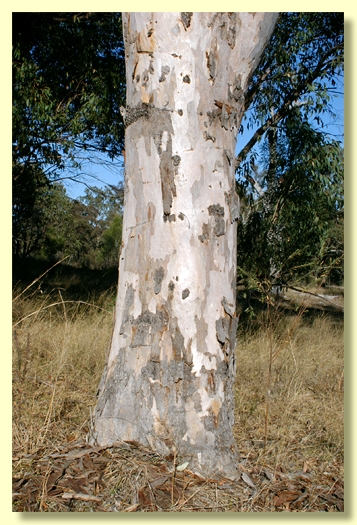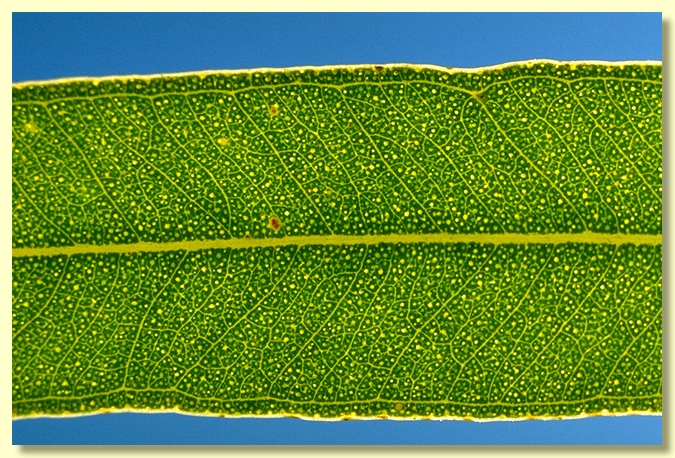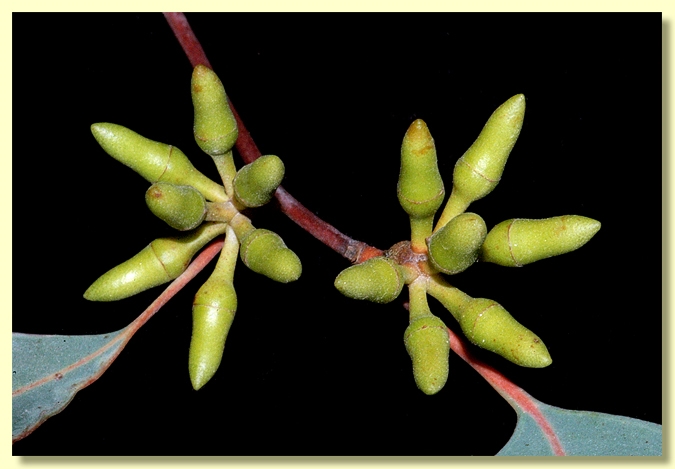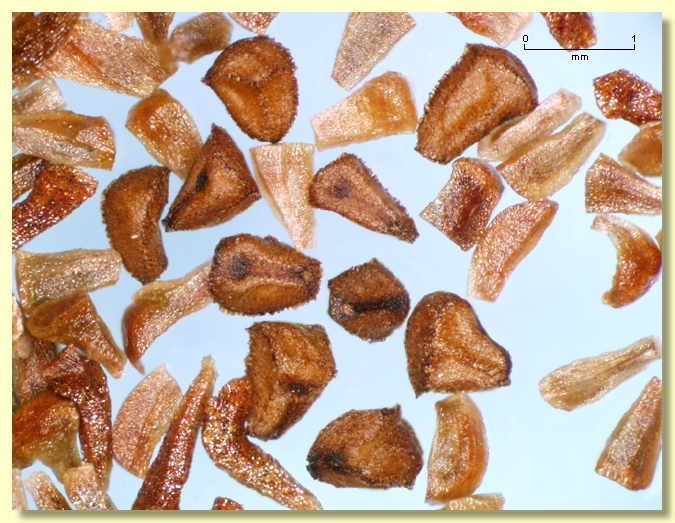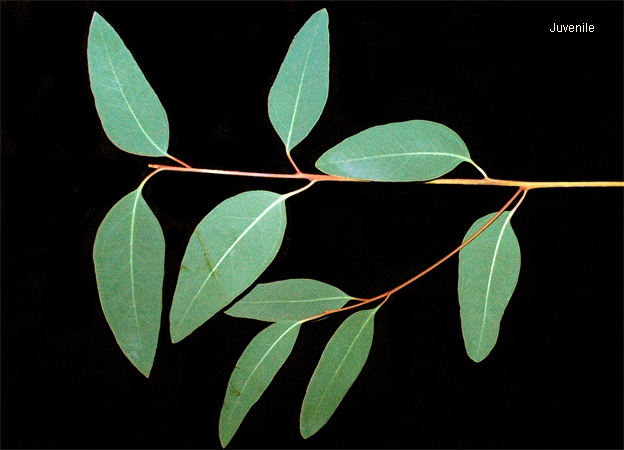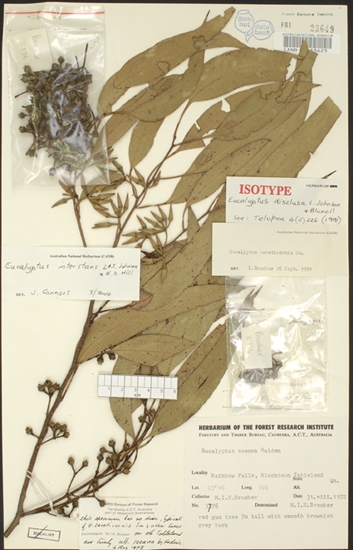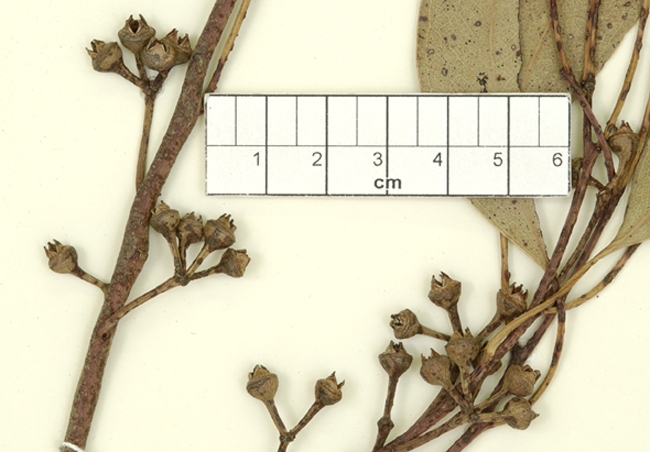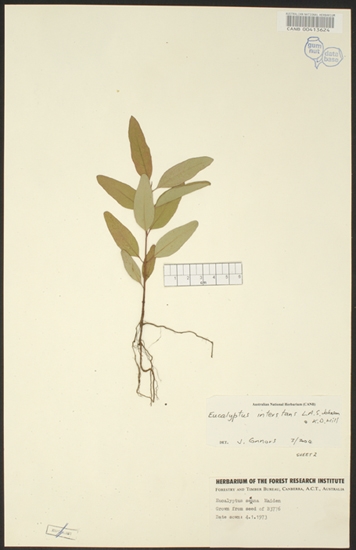Eucalyptus | Symphyomyrtus | Liberivalvae
Euclid - Online edition
Eucalyptus interstans
Eucalyptus interstans L.A.S.Johnson & K.D.Hill, Telopea 4 (1) 47 (1990).
T: New South Wales: Northern Tablelands: Wilsons Downfall, R.H.Cambage 2833, 4 Sept. 1911; holo: NSW.
Eucalyptus disclusa L.A.S.Johnson & K.D.Hill, Telopea 4 (2) 226 (1991). T: Queensland: Rainbow Falls, Blackdown Tableland, M.I.H.Brooker 3776, 31 Aug. 1972; holo: NSW; iso: CANB.
Tree to 20 m tall. Forming a lignotuber.
Bark smooth, mottled grey, white, pink or orange.
Juvenile growth (coppice or field seedlings to 50 cm): stem square in cross-section; juvenile leaves alternate, petiolate, ovate to broadly lanceolate, (5)8–12(14) cm long, 3–6.5 cm wide, base tapering to petiole to rarely rounded, dull, green.
Adult leaves alternate, petiole 1.7–2.7(3) cm long; blade lanceolate to falcate, 8–18 cm long, 1–3.2 cm wide, base tapering to petiole, concolorous, dull, green, side-veins acute or at an angle slightly greater than 45° to midrib, moderately to densely reticulate, intramarginal vein present, oil glands mostly island.
Inflorescence axillary unbranched, peduncles 0.7–1.6 cm long, buds 7, 9 or 11, pedicellate (pedicels 0.3–0.7 cm long). Mature buds elongated-ovoid (1.1–1.4 cm long, 0.3–0.5 cm wide), green to creamy, scar present, operculum conical to horn-shaped (0.8–1.1 cm long), stamens erect, anthers cuboid to oblong, versatile, dorsifixed, dehiscing by longitudinal slits (non-confluent), style long, stigma tapered, locules 3 or 4, the placentae each with 6–8 vertical ovule rows. Flowers white.
Fruit pedicellate (pedicels 0.2–0.5 cm long), cup-shaped to hemispherical, 0.3–0.6 cm long, (0.5)0.6–0.8 cm wide, outer operculum scar prominent as a broad vertical rim, disc annular and free from the 3 or 4 strongly exserted valves.
Seeds brown, 0.9–1.2 mm long, pyramidal to ± linear, dorsal surface smooth, hilum terminal.
Cultivated seedlings (measured at ca node 10): cotyledons bilobed to oblong; stems square in cross-section; leaves always petiolate, opposite for 4 to 6 nodes then alternate, ovate, 5.5–8 cm long, 2–4 cm wide, base tapering to rounded, margin entire, apex pointed to rounded, dull, mid-green.
Flowering has been recorded in June.
A small to medium-sized woodland red gum tree with two disjunct populations, one from the Blackdown Tablelands area of central Queensland (formerly described as E. disclusa but rejected by the authors of this work—see notes below) and the other from the Warwick–Stanthorpe–Legume region of southern Queensland and northern New South Wales through to the Emmaville region on the Northern Tablelands of New South Wales. Eucalyptus interstans is characterised by its smooth bark, the ovate to broadly lanceolate juvenile leaves, the dull green, narrowly lanceolate to lanceolate adult leaves, the non-glaucous buds with a long, narrow, acute operculum and the fruit with strongly exserted valves and an annular disc which is free from the ovary roof.
E. interstans belongs to a small group of red gums that is distinguished by having fruit with an annular disc. Other members of this group are E. bancroftii, E. parramattensis, E. prava and E. seeana. E. interstans is closely related to E. seeana and differs by the juvenile leaves, which are narrowly lanceolate in E. seeana and ovate to broadly lanceolate in E. interstans. E. interstans is also closely related to E. bancroftii, which normally has much broader adult leaves, normally wider than 3 cm in E. bancroftii and narrower than 3 cm in E. interstans. E. prava is a small tree or mallee which differs by having glaucous buds and fruit, and dull grey-green to blue-grey to glaucous adult leaves. E. parramattensis has much smaller ovoid buds with a shorter, bluntly acute to rounded operculum.
Within its area of occurrence, E. interstans may be confused with E. tereticornis, another closely related red gum. E. tereticornis is normally a well-formed tree which can be distinguished by having fruit with a steeply ascending disc that is fused to the ovary roof.
In the original description for E. disclusa, no comparison was made with E. interstans. Both have broad juvenile leaves. Instead, E. disclusa was compared to E. seeana, which clearly differs by having narrow juvenile leaves. Comparison between E. disclusa and E. interstans, on specimens held at CANB, show that the juvenile leaves of E. disclusa are slightly wider than those of E. interstans and that E. disclusa tends to have a flatter disc than E. interstans. However, the juvenile leaf dimensions overlap and the disc shape is not consistent within the population of E. disclusa on the Blackdown Tableland, and therefore E. disclusa is regarded by the authors of EUCLID as being conspecific with E. interstans.
MORE ABOUT RED GUMS AND OTHER ASSOCIATED GROUPS
Eucalyptus interstans: Latin inter, between and stans, standing, referring to the position of this taxon as an intermediate between E. prava and E. seeana, in both geographical and morphological senses.


